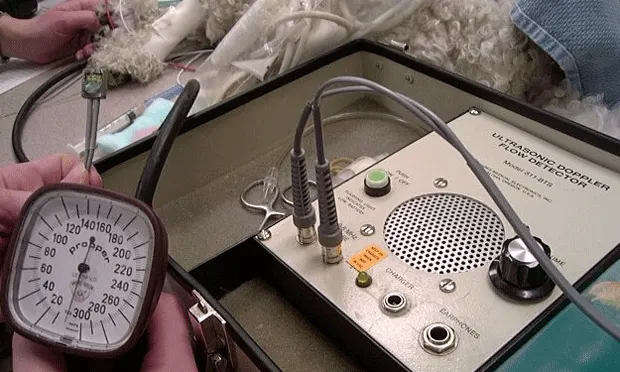Anesthesia Monitoring: Raising the Standards of Care

Figure 1 (above). Doppler blood pressure monitors are relatively inexpensive and provide systolic blood pressure readings if used with a properly sized cuff, but they have the disadvantage of not being able to provide diastolic or mean arterial blood pressure readings.
General anesthesia is a “necessary evil” in daily practice arising from the constant need to provide sensory deprivation to noxious surgical and dental stimuli while maintaining normal blood pressure and perfusion to prevent end-organ damage. Too frequently, however, hypotension, hypoperfusion, and potential end-organ damage are not recognized in anesthetized patients as a result of the unavailability of monitoring equipment, improper use of that equipment, or failure to recognize inherent limitations in its technology (Figure 1).
The American College of Veterinary Anesthesiologists (ACVA) has established guidelines for basic evaluation of circulation, tissue perfusion, oxygenation, and ventilation for all animals placed under heavy sedation or general anesthesia.1,2 Incorporating these monitoring techniques in practice not only helps ensure better outcome on an individual patient basis, it raises the standards of care across the profession.
Figure 2. Monitoring decreases the risk for anesthesia-related complications in both young and old patients. In many general practices, the bulk of anesthesia is performed on healthy young animals for elective spays or neuters or on aged patients, such as this Pomeranian with Cushing’s disease and mitral insufficiency.

Indications
Even young, apparently healthy animals can have adverse reactions to anesthesia. By implementing routine monitoring during anesthesia and sedation, the veterinary team can recognize inadequate tissue perfusion, oxygenation, or ventilation before severe and/or irreversible complications occur (Figure 2). In addition to using more advanced monitoring equipment, ACVA guidelines promote the use of personnel and routine equipment to make minimal anesthetic monitoring easier (see Guidelines for Anesthesia Monitoring). There are no contraindications to anesthesia monitoring, although it may be viewed by some as cumbersome, expensive, or unnecessary.
Guidelines for Anesthesia Monitoring
The following guidelines for monitoring tissue perfusion, oxygenation, and ventilation are based on standards set by the ACVA.2 Note that while evaluation of tissue perfusion and ventilation does not require specialized equipment, use of advanced monitoring techniques allows more accurate assessment of all 3 parameters.1. Circulation and Perfusion
Palpate pulse
Rate
Pulse deficits
Character/quality
Evaluate capillary refill time
Check mucousmembrane color
Auscult heartbeat
Perform ECG
Measure blood pressure
Doppler
Oscillometric
Arterial catheter and pressure transducer
Conduct pulse oximetry
2. Oxygenation
Conduct pulse oximetry
Conduct arterial blood gas analysis
3. Ventilation
Observe chest excursions
Auscult lung sounds
View movement of airwithin endotracheal tube or rebreathing bag
Monitor end-tidal CO2
Conduct arterial blood gas analysis
Advantages
Early Detection and Intervention
Whether they are used alone or in combination, sedatives, muscle relaxants, induction agents, and gas anesthesia all have inherent risks for depressing cardiac output, causing peripheral vasodilation or vasoconstriction, decreasing tissue perfusion, and causing hypoventilation. Lack of tissue oxygenation and inadequate elimination of carbon dioxide (CO2) waste can result in cellular acidosis, impaired enzymatic function, cellular oxygen debt and, in the most extreme cases, cell death. In the past, the use of anesthesia was considered successful if the animal woke up after, and not during, the surgical procedure. Today, routine monitoring can allow early detection of—and quicker intervention for—hypoventilation, hypoxia, and hypotension.3
Tailored Treatment
In addition to recognizing anesthesia-related complications, the use of monitoring equipment allows the veterinary team to tailor inhalant and intravenous anesthesia to each patient’s individual needs and responses. A more balanced approach to anesthesia not only reduces complications but often results in smoother recovery.
Disadvantages
One of the first reasons many practices cite for not doing routine anesthesia monitoring is, “We don’t need it; I’ve never had a problem.” In addition, two major perceived disadvantages to monitoring a patient during anesthesia are the high cost of monitoring equipment and lack of knowledge about its use.
Too Costly
A primary concern in many practices is that the equipment is prohibitively expensive. However, availability of different purchasing options can help overcome cost concerns. For example, rather than purchasing separate electrocardiogram (ECG), pulse oximetry, end-tidal CO2, and Doppler blood pressure monitors, many companies offer basic equipment with options for adding equipment. Basic equipment might include an ECG combined with an oscillometric blood pressure monitor, while add-on equipment to accommodate the growing needs of a practice might include direct arterial blood pressure and end-tidal CO2 monitors. By making an initial purchase and then upgrading, the up-front expense may be rendered less daunting.
A second perceived disadvantage is based on the practice losing money if the costs of the equipment and its use are not transferred to the client. While arguably the benefits to the patient may far outweigh the cost to the practice, this view is not universal in today’s economic environment. In many of today’s practices, clients may be unable to pay for the added cost of anesthesia monitoring.
This concern can be addressed in two ways: The first is to incorporate the cost of equipment use into the cost of a procedure or associated anesthesia. Second, the cost can be itemized into the estimate and invoice so clients have a clear view of what they are paying for. Itemization of this service can translate into the educated client’s perception that the pet is receiving a higher standard of care at your facility (see Debunking the Expense Argument).
Debunking the Expense Argument
Don’t believe you can afford the cost of anesthesia monitoring equipment? The payback can come more quickly than you might realize. For example, say you perform a minimum of 2 dental procedures per week plus 1 spay and 1 neuter:
4 procedures/week × 52 weeks = 208 procedures/year
If a piece of monitoring equipment costs $1000 and you charge each client an additional $5 per procedure for anesthesia monitoring, the cost of that equipment would be recouped within 1 year of purchase:
208 cases × $5/case = $1040
Itemizing the equipment cost as an anesthesia fee on the invoice helps clients better understand what they are being charged for and shows them that you are practicing high-quality medicine.
Too Confusing
Another perceived disadvantage is that the technology is troublesome and, in some cases, is too slow and thus does not provide timely information. When purchasing monitoring equipment, have the representative conduct an in-service program so the veterinary team can be trained in proper use of the equipment, its sensitivity and specificity, and how to troubleshoot different scenarios, as well as what the equipment is showing and how that information can be applied to patient care.
Careful training of personnel is as important as the monitoring equipment itself, so the values obtained from monitoring can be used to make appropriate changes in anesthetic depth and to treat hypoxia, hypoventilation, or hypotension as necessary.
Clinical Impact
While minimal monitoring includes the use of a stethoscope and finger palpation for pulse pressure, more advanced monitoring equipment allows a more detailed, accurate assessment of the patient’s oxygenation, ventilation, and tissue perfusion status. Hypoxemia and hypotension, when recognized, can be treated early before cellular hypoxia and cellular death occur (see Table). Bradycardia, hypoventilation, and poor perfusion can also be recognized before cardiac or respiratory arrest results. In organs such as the kidneys, which are exquisitely sensitive to hypoxia and hypotension, this could lead to better long-term survival.
Knowledge of these variables allows the anesthetist to intervene early and appropriately when complications occur and prevent acute or long-term end-organ damage. Once anesthesia monitoring becomes routine in a practice, the perceived disadvantages diminish and the bar can continue to be raised for the standards of care.
ACVA = American College of Veterinary Anesthesiologists